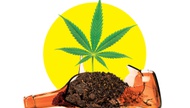This year, Nevada’s cannabis industry celebrates five years of legal recreational sales. In that time, the number of dispensaries has grown from 55 to 92 statewide. Those establishments brought in more than $1 billion in taxable sales last fiscal year, for a total of $157.7 million in excise tax in 2021. Compared to 2017-2018, the recreational industry’s fledgling fiscal year, that’s an increase of 67% in the number of dispensaries and an increase of 89.4% in taxable sales—not to mention the dispensary license fees that the state rakes in, which totaled more than $5.2 million in 2020.
Hashing out the numbers, the cannabis industry seems to be delivering on promises made when Nevadans still were grappling with how they’d vote on the 2016 ballot initiative that legalized recreational sales. Advocates often referenced how a recreational industry could bolster revenues, which could then be used for schools and other areas of the state that lack funding. Per Nevada law, that $157.7 million in excise taxes from last year will go into the state’s distributive schools account to fund education.
The Source, which started with one medical and recreational dispensary in 2017 and has expanded to four retail locations including Reno, has launched a second cultivation facility and increased its production size nearly fivefold over the past three years. “We were cultivating a little less than 1,000 pounds per year about three years ago. And now, our goal [and we’re very close to it] is to cultivate 5,000 pounds per year out of both facilities,” says Aaron Nino, chief operating officer of cultivation facilities for the Source.
One of the biggest changes he has noticed in the industry is the ability to cultivate indoors, increasing efficiency and scaling up production. Camp’s indoor growing facility uses LED lights, allowing for up to 24 hours of sunlight and expedited growth. As opposed to one annual harvest for cannabis plants grown outdoors, Nino says Camp will reach a goal of 5,000 pounds of cultivated product if it can get six to eight harvests out of each of its rooms. Such an operation requires daily tending of the plants, so Camp has hired more employees as it has scaled up.
Not every dispensary has its own cultivation facility. But overall, Nevada dispensaries have added thousands of jobs in recent years—from 6,000 in 2018 to 8,200 employees working in cannabis establishments in 2021. According to an annual report from the Nevada Cannabis Association, there were 2,000 additional jobs created by the industry that weren’t directly in cannabis establishments.
After the legalization of recreational cannabis sales in Nevada in 2016, the federal 2018 Farm Bill broadened parameters for the cultivation of industrial hemp—a variety of cannabis plant that contains little to no THC. Since 1937, hemp was prohibited by federal law along with the cannabis variety that can get you high, marijuana.
Eyes bulged at the potential to legally grow and process the plant, especially for its derived compounds called “cannabinoids,” which includes the popular cannabidiol (CBD). Research into the health and medical benefits of such compounds is still in early stages and inconclusive. That didn’t stop demand and production of hemp derivatives like CBD, however.
According to the Nevada Department of Agriculture, which oversees the state hemp program and certifications, the bill led to rapid growth in the number of certificate holders and acreage for the crop—from 115 certified growers with 1,880 acres in 2018, to 213 growers with 14,693 acres in 2019. But in 2020, the number of growers plummeted to 116 with less than half the acreage of the previous year, and further decreased in 2021. As of April 4, there are now 13 certified hemp growers with 246 acres in Nevada.
Cannabis legal expert and president of consulting firm Hemp Ace International Joy Beckerman says many growers joined the hemp industry in 2019, only to find out that there was no legal market for CBD and other cannabinoids. Per federal law, CBD cannot be sold as food or dietary supplements. Those who were looking to get in on the hemp derivative market had to absorb sunk costs, or went out of business largely because of widespread misunderstanding of the federal regulations surrounding CBD and other cannabinoids, which the 2018 Farm Bill did not change.
“The passage of the 2018 Farm Bill has led to the misperception that all products made from or containing hemp, including those made with CBD, are now legal to sell in interstate commerce,” reads a 2019 testimony from Food and Drug Administration Principal Deputy Commissioner Dr. Amy Abernethy. “At present, any CBD food or purported dietary supplement products in interstate commerce is in violation of the Food, Drug and Cosmetic Act.”
Without being able to market their product, growers across the country ended up storing thousands of gallons of hemp distillate. “Everyone lost money across the board, except for folks that were vertically integrated, or had contracts that paid,” Beckerman explains.
Other states, including New York, have developed regulations for hemp derivatives like CBD to be sold outside of cannabis dispensaries. Since the 2018 Farm Bill passed, the FDA has not created the regulatory framework that is necessary for the hemp extract market to thrive, Beckerman says. “It has left the states to decide … are we going to allow you to market these hemp extract products as dietary supplements and food additives?”
In addition to legal loopholes, hemp experts say a lack of infrastructure to process industrial hemp and new state rules and regulations have further inhibited economic growth. Assistant professor and state specialist M.L. Robinson and horticulturalist Marysia Morawska with UNR Cooperative Extension have spent decades researching best practices for growing and producing industrial hemp.
Aside from cannabinoids, hemp can be processed for other uses, including textiles and sturdy building materials. “The intent of industrial hemp would be to use the plant for … quadruple-purpose crops, so that you can utilize it for animal feed, for grain, for oil, for the roots, for whatever other purposes,” Morawska says. But the infrastructure to process hemp crops is virtually nonexistent in the state and across the country, she explains. “Without the ability to process at that scale, we’re kind of pinching out the small grower, and we’re also making it really difficult for the larger growers to come in.”
Robinson says development of the industrial hemp sector in Nevada also has been “stymied” by expensive licensing fees and additional regulations that have cropped up over the past few years, making cultivation of hemp more “cumbersome.” Applying for a hemp grower certificate now costs $900 (compared to $500 before 2020)—not to mention fees per acre of production and charges for state inspections. He says the full economic benefits of hemp remain largely untapped in Nevada.
Click HERE to subscribe for free to the Weekly Fix, the digital edition of Las Vegas Weekly! Stay up to date with the latest on Las Vegas concerts, shows, restaurants, bars and more, sent directly to your inbox!






